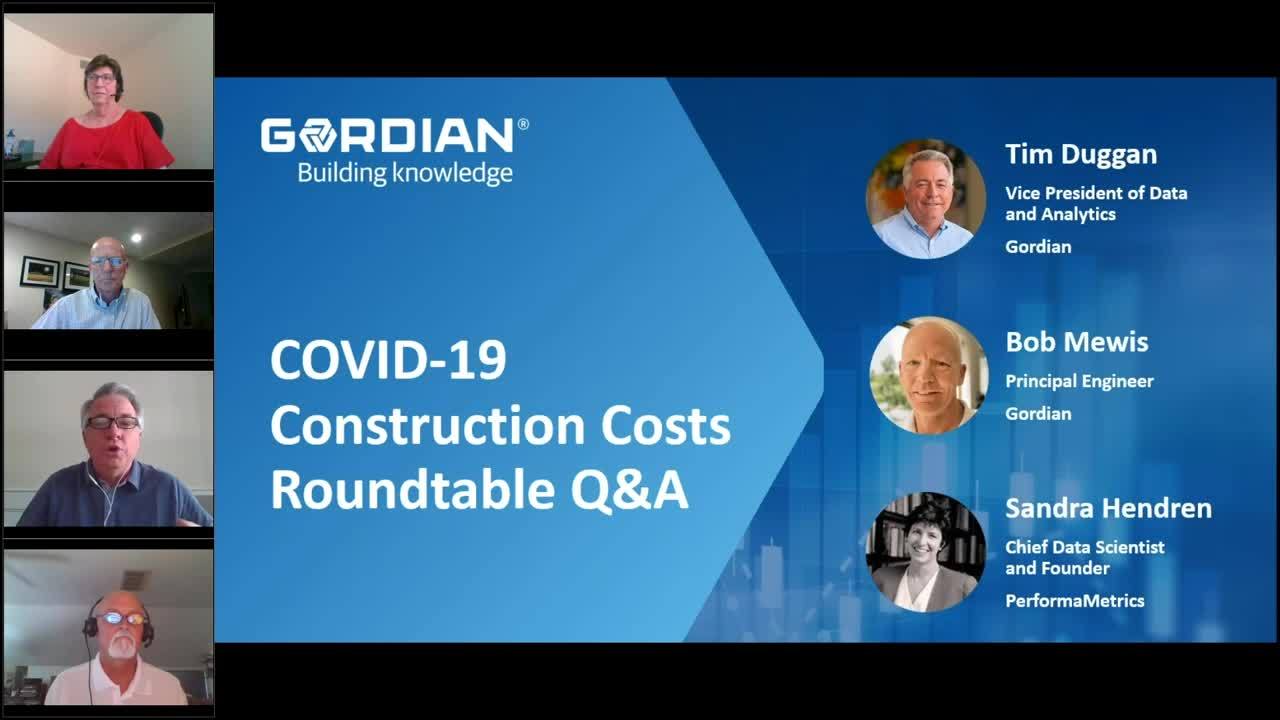
Q&A: COVID-19 Construction Costs Roundtable
July 15, 2024
We’ve received dozens of great questions about the COVID-19 pandemic’s impact on construction costs since our roundtable discussion. Our expert panel reconvened to answer some of the most pressing questions and provide an update on construction cost changes since the beginning of the pandemic. Watch the above video for the entirety of the discussion. Answers to some of the most popular questions are below. They have been edited for length.
It’s been a while since the COVID-19 Construction Costs Roundtable. Do we have any clearer picture of how the pandemic is generally impacting construction costs?
Tim Duggan, Gordian Vice President of Data and Analytics: We are starting to get more details and info from the street on what prices are doing and we are not year hearing of any statistically significant change. One of the things we do is watch price indexes and a number of them have had some changes since early February.
• Oil price index has dropped by more than 40%.
• Lumber price index has dropped more than 30%.
• Aluminum price index has dropped more than 12%.
• Copper price index has dropped more than 9%.
• Iron Ore price index has dropped less than 1%.
These indexes are leading indicators, and all of them are on a downward trajectory. We’re tracking material prices at the suppliers, where our contractors buy them.
Gordian has added items to the Construction Task Catalogue® (CTC) to help customers use Job Order Contracting (JOC) as part of their COVID-19 response efforts. Are these new tasks in the CTC automatically available, or will they be available during the next round of Job Order Contracting bids?
Bob Mewis, Principal Engineer of RSMeans data: A current Job Order Contracting client can request to have these COVID-19-related tasks added to their contract now, but they need to make that request. However, once a new contract starts, these tasks will be included.
What are the benefits of using unit prices or construction Tasks from a Gordian Job Order Contract in our current environment?
Bob: Even in this current situation, the benefit of using unit prices in a construction task catalog is that the owner and the contractor know what the prices are ahead of time, and they are contractually obligated to use those prices. Controlling costs is a direct benefit of using the Construction Task Catalogue.
In our COVID-19 Construction Costs Roundtable, we talked about healthcare industry indicators that you’re expecting to impact cost models. Can you elaborate on or give an example of what those indicators might be and how you will use them?
Sandra Hendren, Data Scientist, Founder of PerformaMetrics: Since the first webinar, I have done more research on healthcare indicators and I found the most wonderful website, Our World in Data. They have a huge section of COVID-19 data, including 11 indicators I’ll be downloading. I will certainly look at the total confirmed COVID deaths versus population to standardize the data across cities of different sizes. I’ll take these indicators and do exploratory work against RSMeans data. Some COVID-specific indicators are so highly correlated with our existing economic indicators that I have to remove one to avoid counting them twice.
I’ll do what is called feature engineering, meaning I will take some of these COVID-19 indicators and look at the ratio of the indicator to an economic indicator like the PPI [Producer Price Index] for crude petroleum domestic production to explore for correlations. At this point, I’m just looking for structure, meaning I’m looking for the most fundamental underlying relationship to define the structure of material, labor and equipment cost drivers.
Are the Q1 2020 construction costs in RSMeans Data Online a forecast based on previous costs or is a collection of current data?
Tim: Our Q1 data and our Q2 data are costs we have collected and analyzed, just as we’ve done for the last 70-some years. The 2020 Q3 data you see in RSMeans Data Online is our predictive data. That prediction is a combination of our predictive annual data and our predictive quarterly data — that’s what you’re seeing all the way out to Q3 of 2023.
If current construction precautions like wearing extra protective gear or practicing social distancing continue, what impact will those precautions have on project costs?
Bob: Costs that will need to be considered include the purchase of PPE [personal protective equipment]. That’s going to come out of the owner’s pocket sooner or later. Employees will need to be trained on the proper fit — the actual putting on — of PPE equipment and sealing that equipment if necessary. Employees will need to be trained to recognize when PPE has worn out, when it’s time to change or replace it. We also have to train employees how to properly doff PPE equipment. That’s all going to cost money and time. There’s going to be losses in productivity. I think that’s a given.
With the time required to don and doff PPE and the possible decontamination procedures that the tradespeople will need to go through, we have to consider the attitude of the tradespeople. Suddenly we’re asking them to go into situations where their wellbeing, could be at risk. Some people may hesitate to do that, and we might see even more of a shortage of tradespeople because they don’t want to put themselves through that. These are all speculations on my part, but I think these are the cost considerations people will need to make going forward.
Share this:


